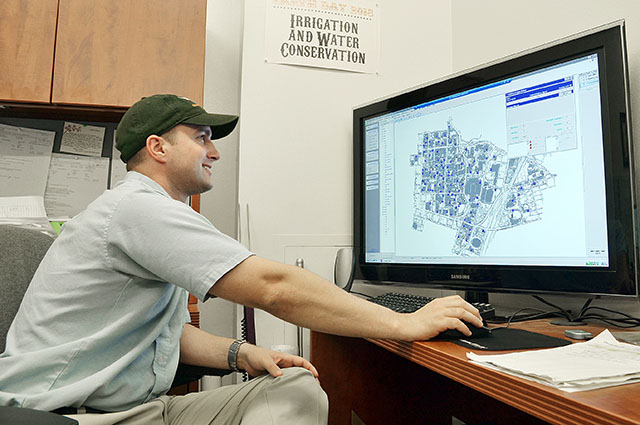UT’s High-Tech Irrigation System Set to Go Live on the Web

Markus Hogue, UT-Austin’s irrigation and water conservation coordinator, monitors 2,300 irrigation zones on a system that will soon be viewable on the Internet. Photo by Marissa Barnett.
By Marissa Barnett
For Reporting Texas and The Dallas Morning News
AUSTIN — A landscape worker for the University of Texas walked into Markus Hogue’s office recently with a request.
He needed the water shut off in a courtyard for maintenance. Hogue pecked at his keyboard, and in 20 seconds it was done.
Hogue, UT’s coordinator of irrigation and water conservation, uses a $2.1 million, high-tech system to control 2,300 watering zones.
In a state plagued by drought, the computerized monitoring system is on the cutting-edge of the new cry for conservation.
Hogue can see it all happen on his 40-inch monitor. And soon, so can everyone else, when his view goes live on the Internet. It will show what’s being watered and how much is being used.
“I can brag all day about saving water, but people want to see the numbers,” said Hogue, 31, who has an information systems degree from UT-Arlington. “We’re going to give them their numbers.”
In 2012, the system’s first full year of operation, the university cut water use by more than 100 million gallons, he said.
It did so by finding leaks quickly and using just the amount of water necessary, given soil moisture. That’s a savings of about $800,000 a year on UT’s water bill.
The university now uses about 70 million gallons on plants a year, down from nearly 170 million.
Manufactured by Calsense of Vista, Calif., the UT system links 18,000 water-conserving nozzles and sensors to a central computer.
If it indicates “we don’t need five minutes because it’s cloudy out, then the system may only run water for a minute,” said Greg Boyer, a Calsense product representative.
California State University and Georgia Tech also use the Calsense system. So do cities in Georgia and Washington state.
Hogue said the public dashboard showing UT’s water consumption can be a key research tool.
Students already have been calling for the data, and he said it could become valuable to urban planners, landscape architects, engineers and others.
Hogue and his colleagues are figuring out other ways to cut water consumption by using reclaimed water.
Some new buildings, including the Belo Center for New Media, harvest rainwater for plants and lawns. At the nearby Biomedical Engineering Building, water is collected from air conditioning condensers.
The public dashboard is expected to launch by mid-November.